Organisational Behaviour: Analysis of Culture, Power, Politics, Motivation, and Team Development in Boots
VerifiedAdded on 2023/06/18
|16
|4395
|260
AI Summary
This report analyses the impact of culture, power, politics, motivation, and team development on individual and team behaviour and performance in Boots. It evaluates the content and process theories of motivation and motivational techniques that enable essential achievement of aims. It also explains what makes an effective team as opposed to an ineffective team and applies philosophies and concepts of organizational behaviour within Boots context and give business situation.
Contribute Materials
Your contribution can guide someone’s learning journey. Share your
documents today.
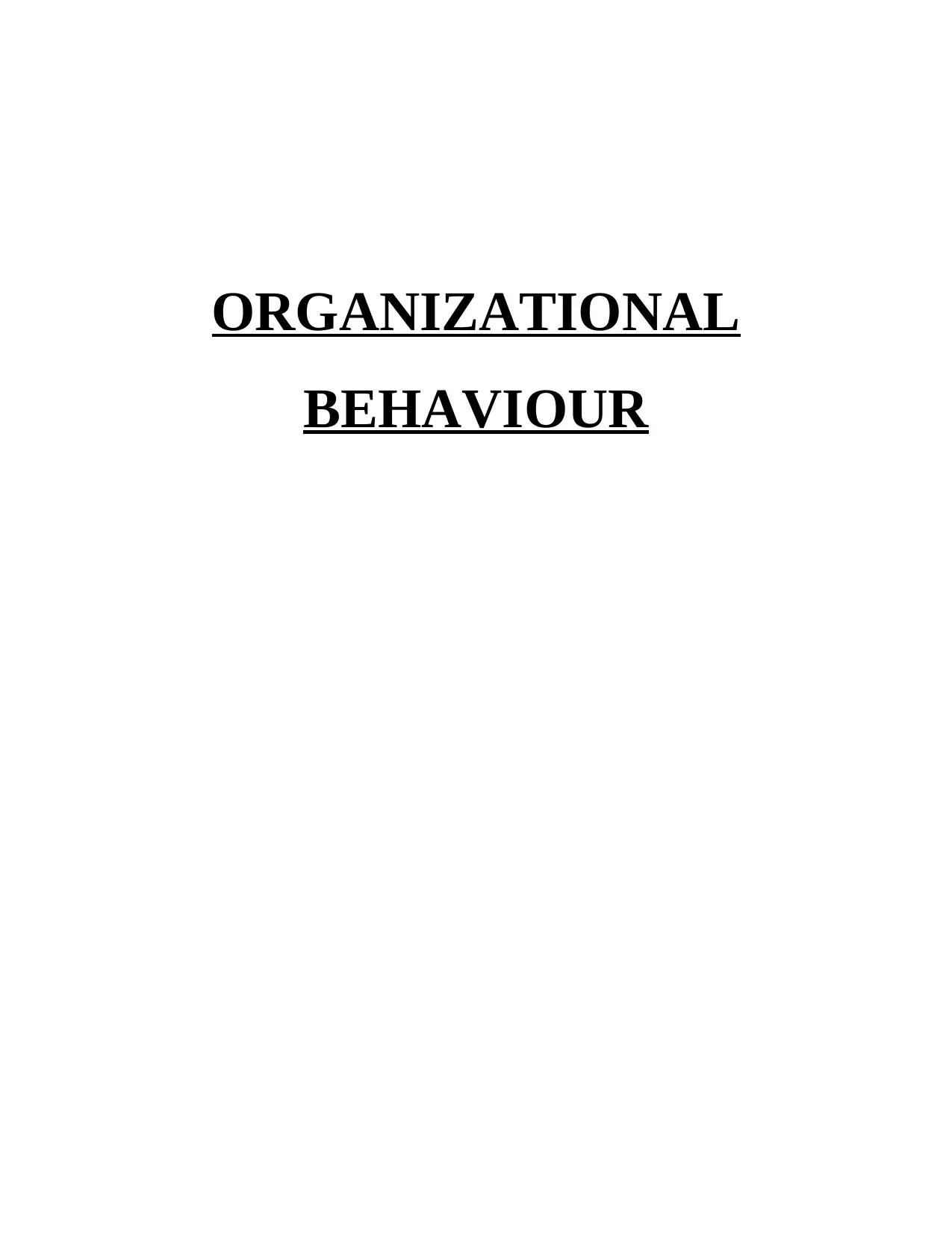
ORGANIZATIONAL
BEHAVIOUR
BEHAVIOUR
Secure Best Marks with AI Grader
Need help grading? Try our AI Grader for instant feedback on your assignments.
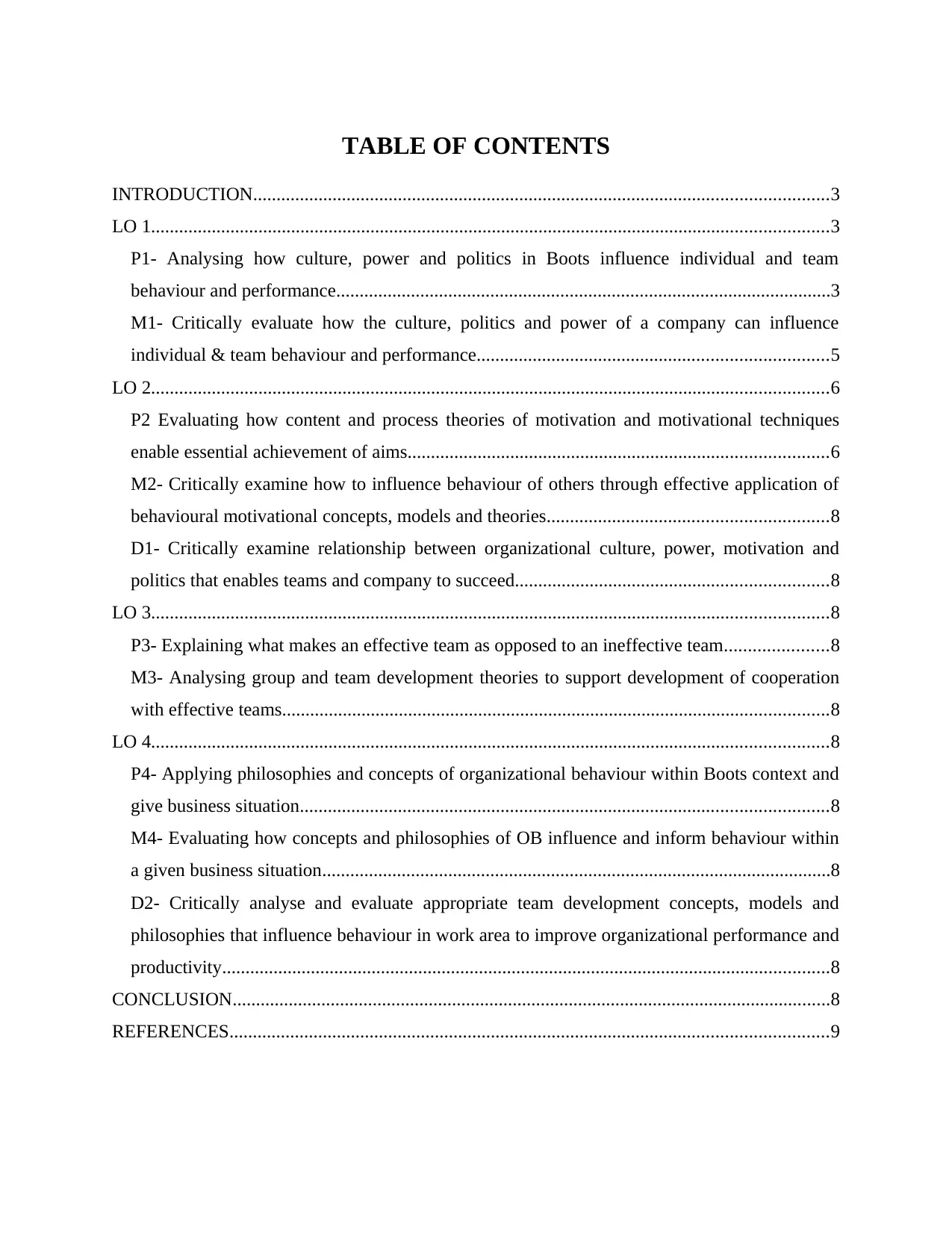
TABLE OF CONTENTS
INTRODUCTION...........................................................................................................................3
LO 1.................................................................................................................................................3
P1- Analysing how culture, power and politics in Boots influence individual and team
behaviour and performance..........................................................................................................3
M1- Critically evaluate how the culture, politics and power of a company can influence
individual & team behaviour and performance...........................................................................5
LO 2.................................................................................................................................................6
P2 Evaluating how content and process theories of motivation and motivational techniques
enable essential achievement of aims..........................................................................................6
M2- Critically examine how to influence behaviour of others through effective application of
behavioural motivational concepts, models and theories............................................................8
D1- Critically examine relationship between organizational culture, power, motivation and
politics that enables teams and company to succeed...................................................................8
LO 3.................................................................................................................................................8
P3- Explaining what makes an effective team as opposed to an ineffective team......................8
M3- Analysing group and team development theories to support development of cooperation
with effective teams.....................................................................................................................8
LO 4.................................................................................................................................................8
P4- Applying philosophies and concepts of organizational behaviour within Boots context and
give business situation.................................................................................................................8
M4- Evaluating how concepts and philosophies of OB influence and inform behaviour within
a given business situation.............................................................................................................8
D2- Critically analyse and evaluate appropriate team development concepts, models and
philosophies that influence behaviour in work area to improve organizational performance and
productivity..................................................................................................................................8
CONCLUSION................................................................................................................................8
REFERENCES................................................................................................................................9
INTRODUCTION...........................................................................................................................3
LO 1.................................................................................................................................................3
P1- Analysing how culture, power and politics in Boots influence individual and team
behaviour and performance..........................................................................................................3
M1- Critically evaluate how the culture, politics and power of a company can influence
individual & team behaviour and performance...........................................................................5
LO 2.................................................................................................................................................6
P2 Evaluating how content and process theories of motivation and motivational techniques
enable essential achievement of aims..........................................................................................6
M2- Critically examine how to influence behaviour of others through effective application of
behavioural motivational concepts, models and theories............................................................8
D1- Critically examine relationship between organizational culture, power, motivation and
politics that enables teams and company to succeed...................................................................8
LO 3.................................................................................................................................................8
P3- Explaining what makes an effective team as opposed to an ineffective team......................8
M3- Analysing group and team development theories to support development of cooperation
with effective teams.....................................................................................................................8
LO 4.................................................................................................................................................8
P4- Applying philosophies and concepts of organizational behaviour within Boots context and
give business situation.................................................................................................................8
M4- Evaluating how concepts and philosophies of OB influence and inform behaviour within
a given business situation.............................................................................................................8
D2- Critically analyse and evaluate appropriate team development concepts, models and
philosophies that influence behaviour in work area to improve organizational performance and
productivity..................................................................................................................................8
CONCLUSION................................................................................................................................8
REFERENCES................................................................................................................................9
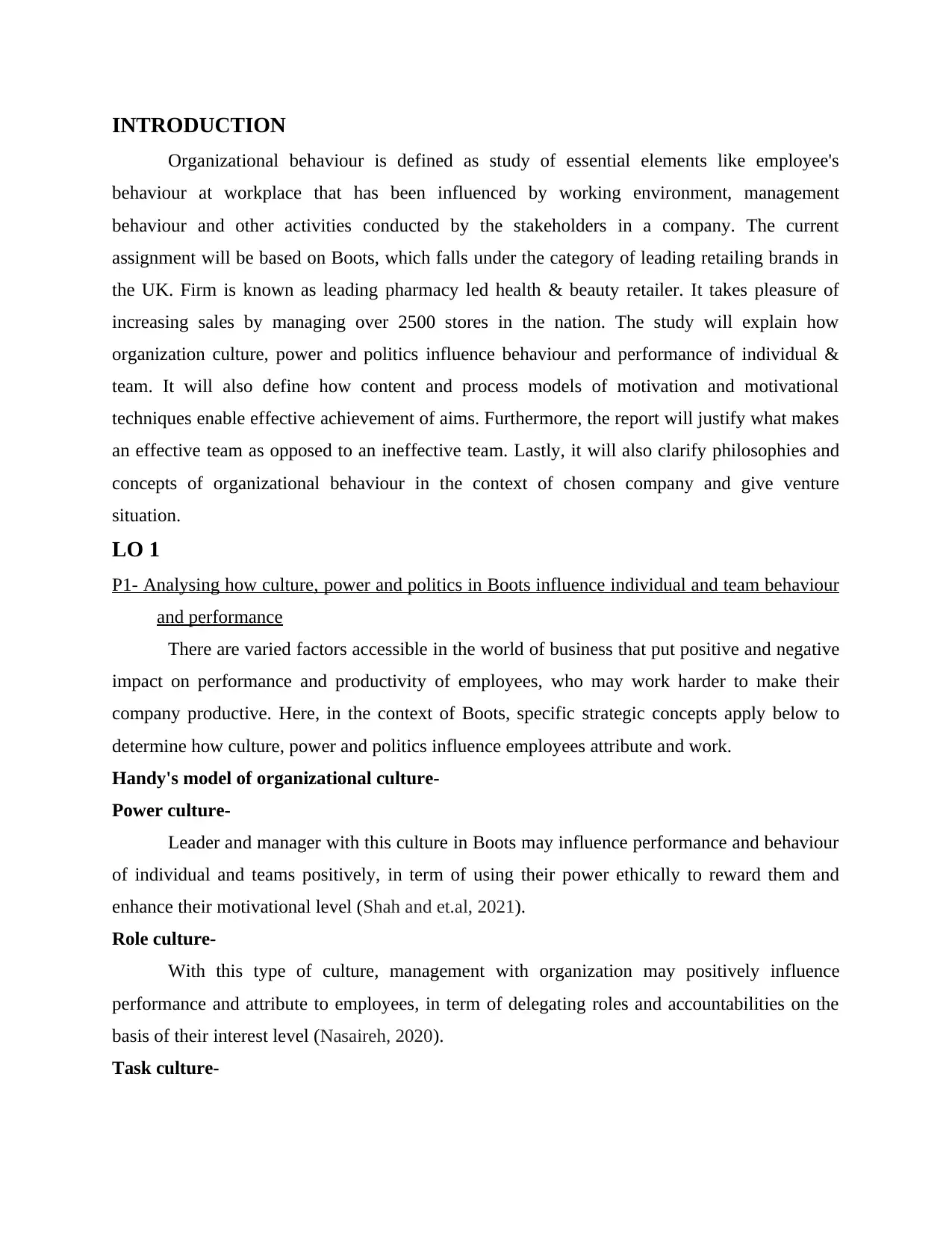
INTRODUCTION
Organizational behaviour is defined as study of essential elements like employee's
behaviour at workplace that has been influenced by working environment, management
behaviour and other activities conducted by the stakeholders in a company. The current
assignment will be based on Boots, which falls under the category of leading retailing brands in
the UK. Firm is known as leading pharmacy led health & beauty retailer. It takes pleasure of
increasing sales by managing over 2500 stores in the nation. The study will explain how
organization culture, power and politics influence behaviour and performance of individual &
team. It will also define how content and process models of motivation and motivational
techniques enable effective achievement of aims. Furthermore, the report will justify what makes
an effective team as opposed to an ineffective team. Lastly, it will also clarify philosophies and
concepts of organizational behaviour in the context of chosen company and give venture
situation.
LO 1
P1- Analysing how culture, power and politics in Boots influence individual and team behaviour
and performance
There are varied factors accessible in the world of business that put positive and negative
impact on performance and productivity of employees, who may work harder to make their
company productive. Here, in the context of Boots, specific strategic concepts apply below to
determine how culture, power and politics influence employees attribute and work.
Handy's model of organizational culture-
Power culture-
Leader and manager with this culture in Boots may influence performance and behaviour
of individual and teams positively, in term of using their power ethically to reward them and
enhance their motivational level (Shah and et.al, 2021).
Role culture-
With this type of culture, management with organization may positively influence
performance and attribute to employees, in term of delegating roles and accountabilities on the
basis of their interest level (Nasaireh, 2020).
Task culture-
Organizational behaviour is defined as study of essential elements like employee's
behaviour at workplace that has been influenced by working environment, management
behaviour and other activities conducted by the stakeholders in a company. The current
assignment will be based on Boots, which falls under the category of leading retailing brands in
the UK. Firm is known as leading pharmacy led health & beauty retailer. It takes pleasure of
increasing sales by managing over 2500 stores in the nation. The study will explain how
organization culture, power and politics influence behaviour and performance of individual &
team. It will also define how content and process models of motivation and motivational
techniques enable effective achievement of aims. Furthermore, the report will justify what makes
an effective team as opposed to an ineffective team. Lastly, it will also clarify philosophies and
concepts of organizational behaviour in the context of chosen company and give venture
situation.
LO 1
P1- Analysing how culture, power and politics in Boots influence individual and team behaviour
and performance
There are varied factors accessible in the world of business that put positive and negative
impact on performance and productivity of employees, who may work harder to make their
company productive. Here, in the context of Boots, specific strategic concepts apply below to
determine how culture, power and politics influence employees attribute and work.
Handy's model of organizational culture-
Power culture-
Leader and manager with this culture in Boots may influence performance and behaviour
of individual and teams positively, in term of using their power ethically to reward them and
enhance their motivational level (Shah and et.al, 2021).
Role culture-
With this type of culture, management with organization may positively influence
performance and attribute to employees, in term of delegating roles and accountabilities on the
basis of their interest level (Nasaireh, 2020).
Task culture-
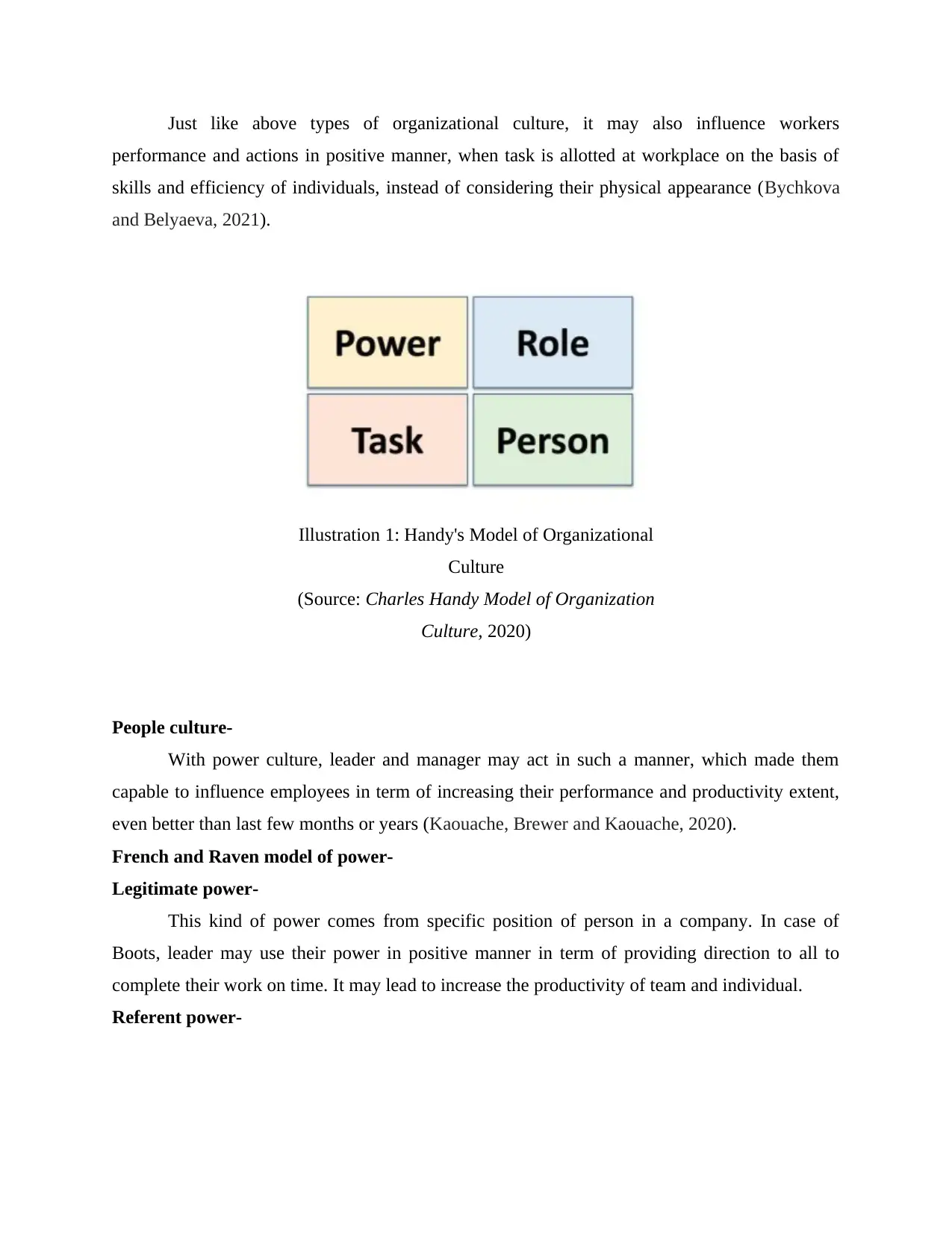
Just like above types of organizational culture, it may also influence workers
performance and actions in positive manner, when task is allotted at workplace on the basis of
skills and efficiency of individuals, instead of considering their physical appearance (Bychkova
and Belyaeva, 2021).
People culture-
With power culture, leader and manager may act in such a manner, which made them
capable to influence employees in term of increasing their performance and productivity extent,
even better than last few months or years (Kaouache, Brewer and Kaouache, 2020).
French and Raven model of power-
Legitimate power-
This kind of power comes from specific position of person in a company. In case of
Boots, leader may use their power in positive manner in term of providing direction to all to
complete their work on time. It may lead to increase the productivity of team and individual.
Referent power-
Illustration 1: Handy's Model of Organizational
Culture
(Source: Charles Handy Model of Organization
Culture, 2020)
performance and actions in positive manner, when task is allotted at workplace on the basis of
skills and efficiency of individuals, instead of considering their physical appearance (Bychkova
and Belyaeva, 2021).
People culture-
With power culture, leader and manager may act in such a manner, which made them
capable to influence employees in term of increasing their performance and productivity extent,
even better than last few months or years (Kaouache, Brewer and Kaouache, 2020).
French and Raven model of power-
Legitimate power-
This kind of power comes from specific position of person in a company. In case of
Boots, leader may use their power in positive manner in term of providing direction to all to
complete their work on time. It may lead to increase the productivity of team and individual.
Referent power-
Illustration 1: Handy's Model of Organizational
Culture
(Source: Charles Handy Model of Organization
Culture, 2020)
Secure Best Marks with AI Grader
Need help grading? Try our AI Grader for instant feedback on your assignments.
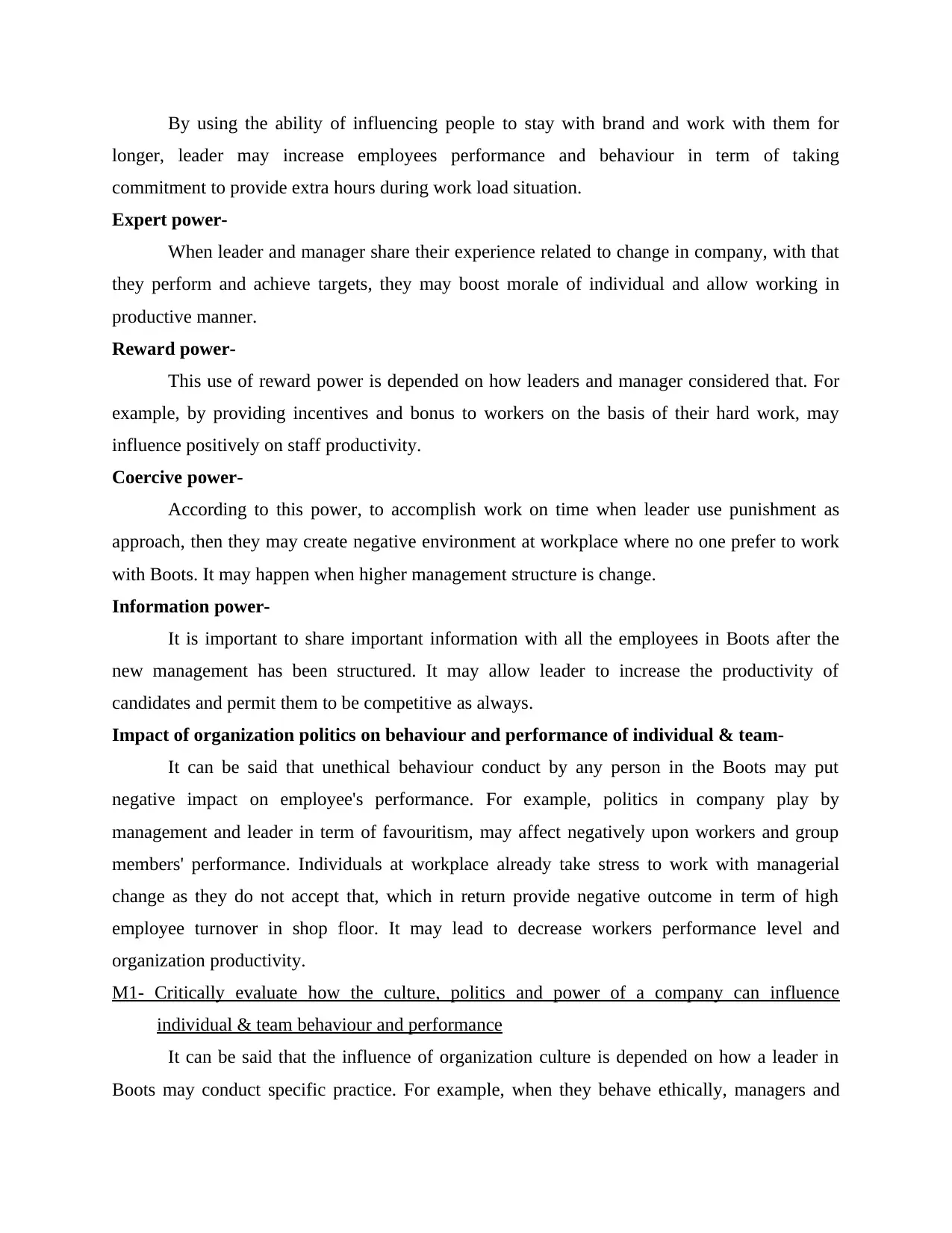
By using the ability of influencing people to stay with brand and work with them for
longer, leader may increase employees performance and behaviour in term of taking
commitment to provide extra hours during work load situation.
Expert power-
When leader and manager share their experience related to change in company, with that
they perform and achieve targets, they may boost morale of individual and allow working in
productive manner.
Reward power-
This use of reward power is depended on how leaders and manager considered that. For
example, by providing incentives and bonus to workers on the basis of their hard work, may
influence positively on staff productivity.
Coercive power-
According to this power, to accomplish work on time when leader use punishment as
approach, then they may create negative environment at workplace where no one prefer to work
with Boots. It may happen when higher management structure is change.
Information power-
It is important to share important information with all the employees in Boots after the
new management has been structured. It may allow leader to increase the productivity of
candidates and permit them to be competitive as always.
Impact of organization politics on behaviour and performance of individual & team-
It can be said that unethical behaviour conduct by any person in the Boots may put
negative impact on employee's performance. For example, politics in company play by
management and leader in term of favouritism, may affect negatively upon workers and group
members' performance. Individuals at workplace already take stress to work with managerial
change as they do not accept that, which in return provide negative outcome in term of high
employee turnover in shop floor. It may lead to decrease workers performance level and
organization productivity.
M1- Critically evaluate how the culture, politics and power of a company can influence
individual & team behaviour and performance
It can be said that the influence of organization culture is depended on how a leader in
Boots may conduct specific practice. For example, when they behave ethically, managers and
longer, leader may increase employees performance and behaviour in term of taking
commitment to provide extra hours during work load situation.
Expert power-
When leader and manager share their experience related to change in company, with that
they perform and achieve targets, they may boost morale of individual and allow working in
productive manner.
Reward power-
This use of reward power is depended on how leaders and manager considered that. For
example, by providing incentives and bonus to workers on the basis of their hard work, may
influence positively on staff productivity.
Coercive power-
According to this power, to accomplish work on time when leader use punishment as
approach, then they may create negative environment at workplace where no one prefer to work
with Boots. It may happen when higher management structure is change.
Information power-
It is important to share important information with all the employees in Boots after the
new management has been structured. It may allow leader to increase the productivity of
candidates and permit them to be competitive as always.
Impact of organization politics on behaviour and performance of individual & team-
It can be said that unethical behaviour conduct by any person in the Boots may put
negative impact on employee's performance. For example, politics in company play by
management and leader in term of favouritism, may affect negatively upon workers and group
members' performance. Individuals at workplace already take stress to work with managerial
change as they do not accept that, which in return provide negative outcome in term of high
employee turnover in shop floor. It may lead to decrease workers performance level and
organization productivity.
M1- Critically evaluate how the culture, politics and power of a company can influence
individual & team behaviour and performance
It can be said that the influence of organization culture is depended on how a leader in
Boots may conduct specific practice. For example, when they behave ethically, managers and
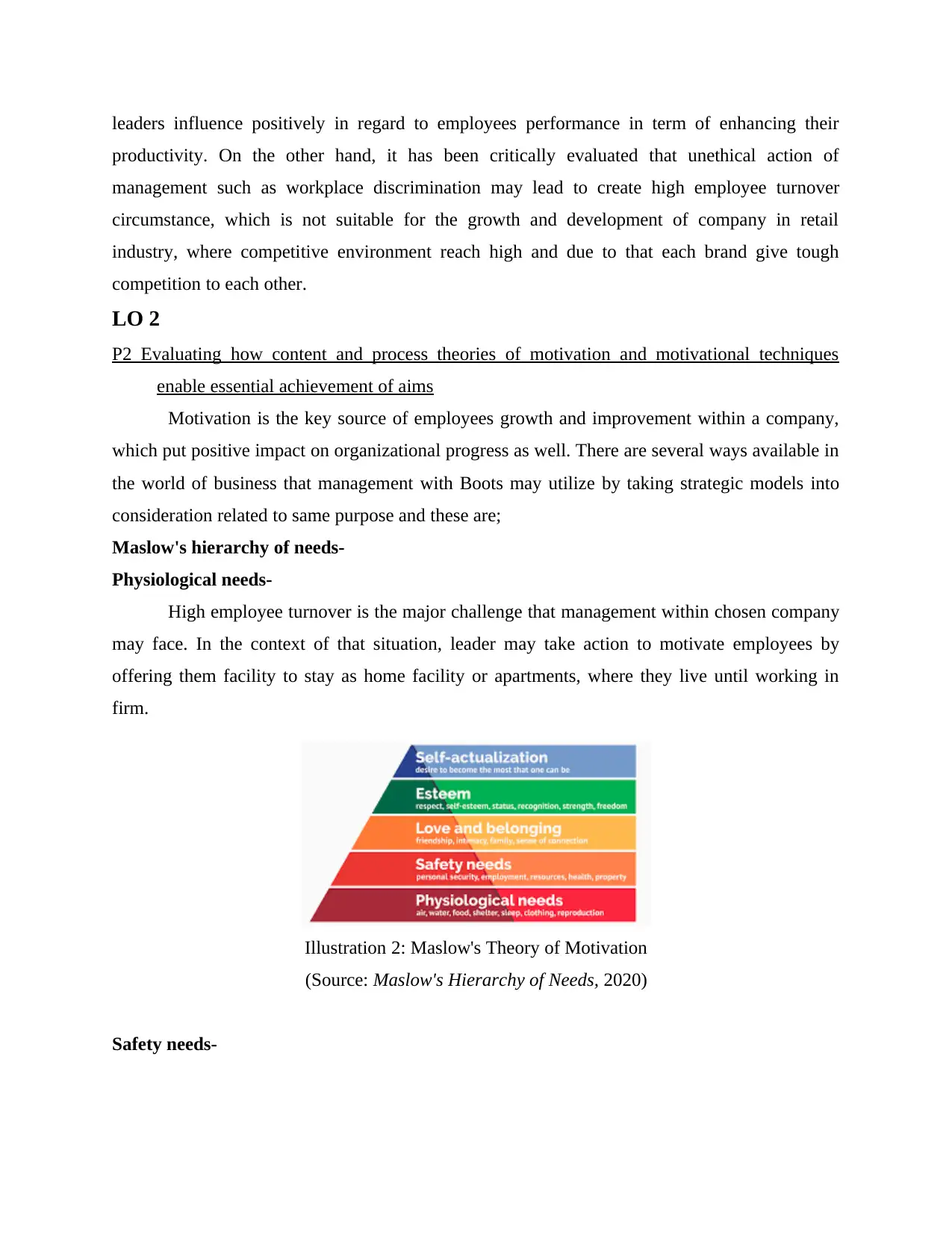
leaders influence positively in regard to employees performance in term of enhancing their
productivity. On the other hand, it has been critically evaluated that unethical action of
management such as workplace discrimination may lead to create high employee turnover
circumstance, which is not suitable for the growth and development of company in retail
industry, where competitive environment reach high and due to that each brand give tough
competition to each other.
LO 2
P2 Evaluating how content and process theories of motivation and motivational techniques
enable essential achievement of aims
Motivation is the key source of employees growth and improvement within a company,
which put positive impact on organizational progress as well. There are several ways available in
the world of business that management with Boots may utilize by taking strategic models into
consideration related to same purpose and these are;
Maslow's hierarchy of needs-
Physiological needs-
High employee turnover is the major challenge that management within chosen company
may face. In the context of that situation, leader may take action to motivate employees by
offering them facility to stay as home facility or apartments, where they live until working in
firm.
Safety needs-
Illustration 2: Maslow's Theory of Motivation
(Source: Maslow's Hierarchy of Needs, 2020)
productivity. On the other hand, it has been critically evaluated that unethical action of
management such as workplace discrimination may lead to create high employee turnover
circumstance, which is not suitable for the growth and development of company in retail
industry, where competitive environment reach high and due to that each brand give tough
competition to each other.
LO 2
P2 Evaluating how content and process theories of motivation and motivational techniques
enable essential achievement of aims
Motivation is the key source of employees growth and improvement within a company,
which put positive impact on organizational progress as well. There are several ways available in
the world of business that management with Boots may utilize by taking strategic models into
consideration related to same purpose and these are;
Maslow's hierarchy of needs-
Physiological needs-
High employee turnover is the major challenge that management within chosen company
may face. In the context of that situation, leader may take action to motivate employees by
offering them facility to stay as home facility or apartments, where they live until working in
firm.
Safety needs-
Illustration 2: Maslow's Theory of Motivation
(Source: Maslow's Hierarchy of Needs, 2020)
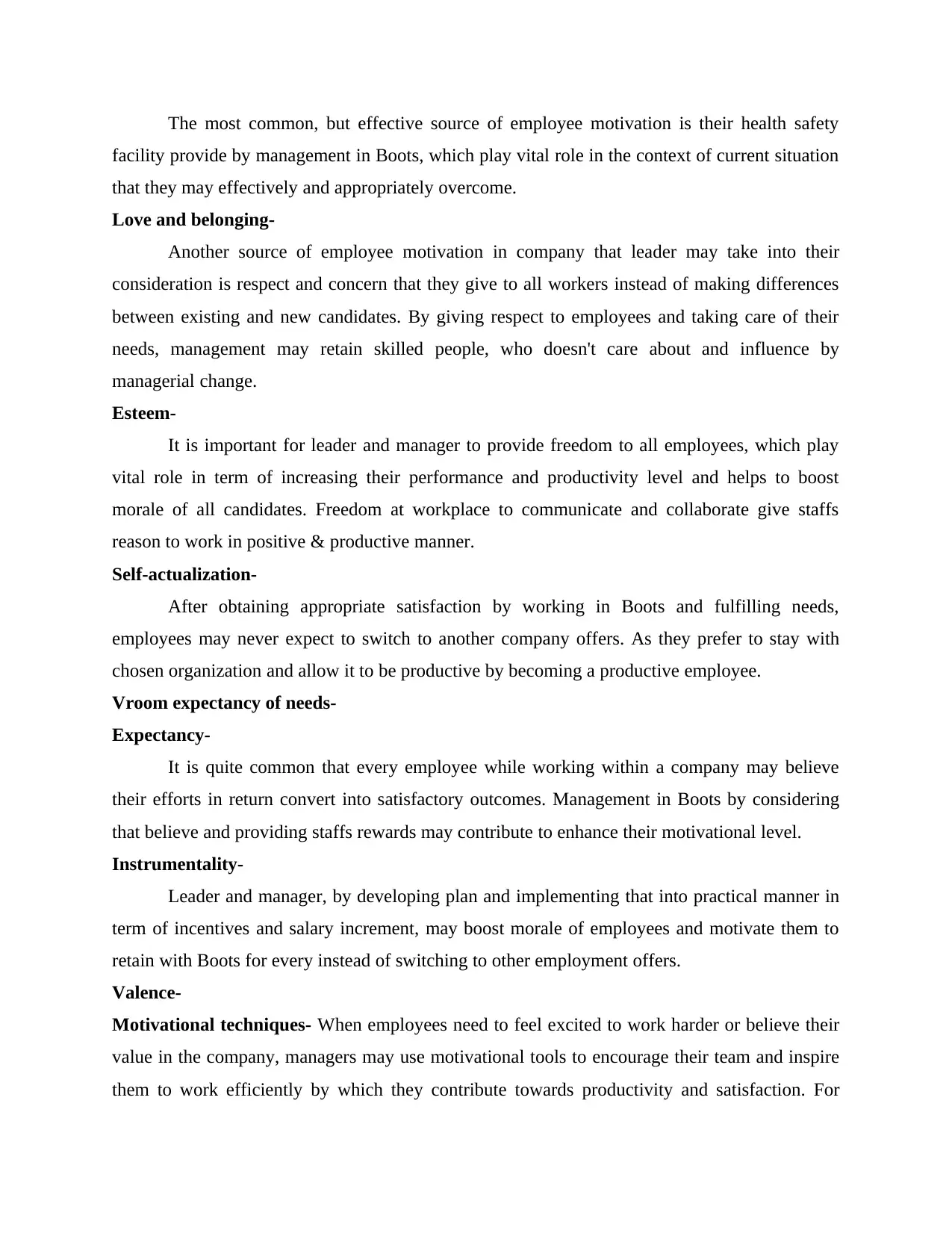
The most common, but effective source of employee motivation is their health safety
facility provide by management in Boots, which play vital role in the context of current situation
that they may effectively and appropriately overcome.
Love and belonging-
Another source of employee motivation in company that leader may take into their
consideration is respect and concern that they give to all workers instead of making differences
between existing and new candidates. By giving respect to employees and taking care of their
needs, management may retain skilled people, who doesn't care about and influence by
managerial change.
Esteem-
It is important for leader and manager to provide freedom to all employees, which play
vital role in term of increasing their performance and productivity level and helps to boost
morale of all candidates. Freedom at workplace to communicate and collaborate give staffs
reason to work in positive & productive manner.
Self-actualization-
After obtaining appropriate satisfaction by working in Boots and fulfilling needs,
employees may never expect to switch to another company offers. As they prefer to stay with
chosen organization and allow it to be productive by becoming a productive employee.
Vroom expectancy of needs-
Expectancy-
It is quite common that every employee while working within a company may believe
their efforts in return convert into satisfactory outcomes. Management in Boots by considering
that believe and providing staffs rewards may contribute to enhance their motivational level.
Instrumentality-
Leader and manager, by developing plan and implementing that into practical manner in
term of incentives and salary increment, may boost morale of employees and motivate them to
retain with Boots for every instead of switching to other employment offers.
Valence-
Motivational techniques- When employees need to feel excited to work harder or believe their
value in the company, managers may use motivational tools to encourage their team and inspire
them to work efficiently by which they contribute towards productivity and satisfaction. For
facility provide by management in Boots, which play vital role in the context of current situation
that they may effectively and appropriately overcome.
Love and belonging-
Another source of employee motivation in company that leader may take into their
consideration is respect and concern that they give to all workers instead of making differences
between existing and new candidates. By giving respect to employees and taking care of their
needs, management may retain skilled people, who doesn't care about and influence by
managerial change.
Esteem-
It is important for leader and manager to provide freedom to all employees, which play
vital role in term of increasing their performance and productivity level and helps to boost
morale of all candidates. Freedom at workplace to communicate and collaborate give staffs
reason to work in positive & productive manner.
Self-actualization-
After obtaining appropriate satisfaction by working in Boots and fulfilling needs,
employees may never expect to switch to another company offers. As they prefer to stay with
chosen organization and allow it to be productive by becoming a productive employee.
Vroom expectancy of needs-
Expectancy-
It is quite common that every employee while working within a company may believe
their efforts in return convert into satisfactory outcomes. Management in Boots by considering
that believe and providing staffs rewards may contribute to enhance their motivational level.
Instrumentality-
Leader and manager, by developing plan and implementing that into practical manner in
term of incentives and salary increment, may boost morale of employees and motivate them to
retain with Boots for every instead of switching to other employment offers.
Valence-
Motivational techniques- When employees need to feel excited to work harder or believe their
value in the company, managers may use motivational tools to encourage their team and inspire
them to work efficiently by which they contribute towards productivity and satisfaction. For
Paraphrase This Document
Need a fresh take? Get an instant paraphrase of this document with our AI Paraphraser
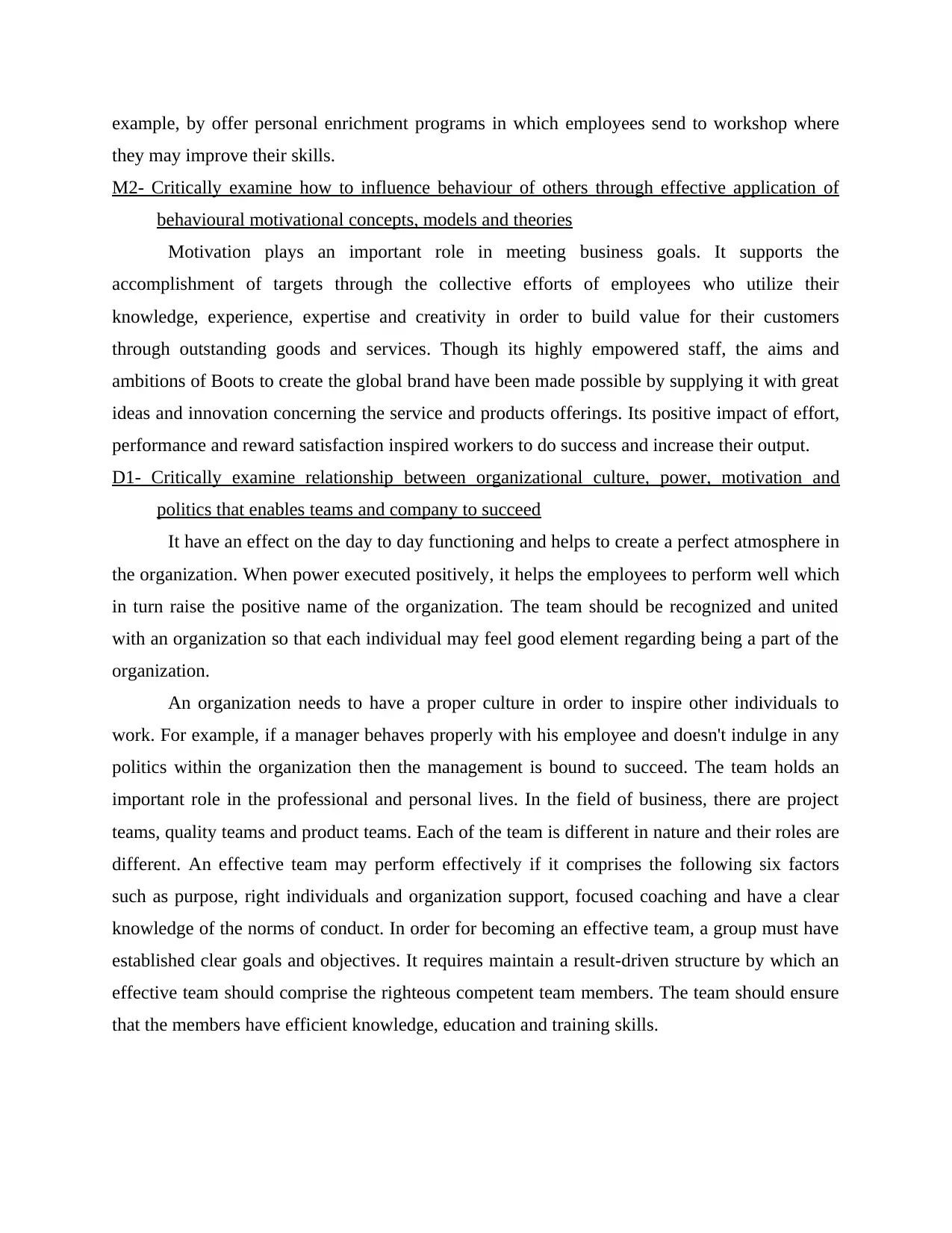
example, by offer personal enrichment programs in which employees send to workshop where
they may improve their skills.
M2- Critically examine how to influence behaviour of others through effective application of
behavioural motivational concepts, models and theories
Motivation plays an important role in meeting business goals. It supports the
accomplishment of targets through the collective efforts of employees who utilize their
knowledge, experience, expertise and creativity in order to build value for their customers
through outstanding goods and services. Though its highly empowered staff, the aims and
ambitions of Boots to create the global brand have been made possible by supplying it with great
ideas and innovation concerning the service and products offerings. Its positive impact of effort,
performance and reward satisfaction inspired workers to do success and increase their output.
D1- Critically examine relationship between organizational culture, power, motivation and
politics that enables teams and company to succeed
It have an effect on the day to day functioning and helps to create a perfect atmosphere in
the organization. When power executed positively, it helps the employees to perform well which
in turn raise the positive name of the organization. The team should be recognized and united
with an organization so that each individual may feel good element regarding being a part of the
organization.
An organization needs to have a proper culture in order to inspire other individuals to
work. For example, if a manager behaves properly with his employee and doesn't indulge in any
politics within the organization then the management is bound to succeed. The team holds an
important role in the professional and personal lives. In the field of business, there are project
teams, quality teams and product teams. Each of the team is different in nature and their roles are
different. An effective team may perform effectively if it comprises the following six factors
such as purpose, right individuals and organization support, focused coaching and have a clear
knowledge of the norms of conduct. In order for becoming an effective team, a group must have
established clear goals and objectives. It requires maintain a result-driven structure by which an
effective team should comprise the righteous competent team members. The team should ensure
that the members have efficient knowledge, education and training skills.
they may improve their skills.
M2- Critically examine how to influence behaviour of others through effective application of
behavioural motivational concepts, models and theories
Motivation plays an important role in meeting business goals. It supports the
accomplishment of targets through the collective efforts of employees who utilize their
knowledge, experience, expertise and creativity in order to build value for their customers
through outstanding goods and services. Though its highly empowered staff, the aims and
ambitions of Boots to create the global brand have been made possible by supplying it with great
ideas and innovation concerning the service and products offerings. Its positive impact of effort,
performance and reward satisfaction inspired workers to do success and increase their output.
D1- Critically examine relationship between organizational culture, power, motivation and
politics that enables teams and company to succeed
It have an effect on the day to day functioning and helps to create a perfect atmosphere in
the organization. When power executed positively, it helps the employees to perform well which
in turn raise the positive name of the organization. The team should be recognized and united
with an organization so that each individual may feel good element regarding being a part of the
organization.
An organization needs to have a proper culture in order to inspire other individuals to
work. For example, if a manager behaves properly with his employee and doesn't indulge in any
politics within the organization then the management is bound to succeed. The team holds an
important role in the professional and personal lives. In the field of business, there are project
teams, quality teams and product teams. Each of the team is different in nature and their roles are
different. An effective team may perform effectively if it comprises the following six factors
such as purpose, right individuals and organization support, focused coaching and have a clear
knowledge of the norms of conduct. In order for becoming an effective team, a group must have
established clear goals and objectives. It requires maintain a result-driven structure by which an
effective team should comprise the righteous competent team members. The team should ensure
that the members have efficient knowledge, education and training skills.
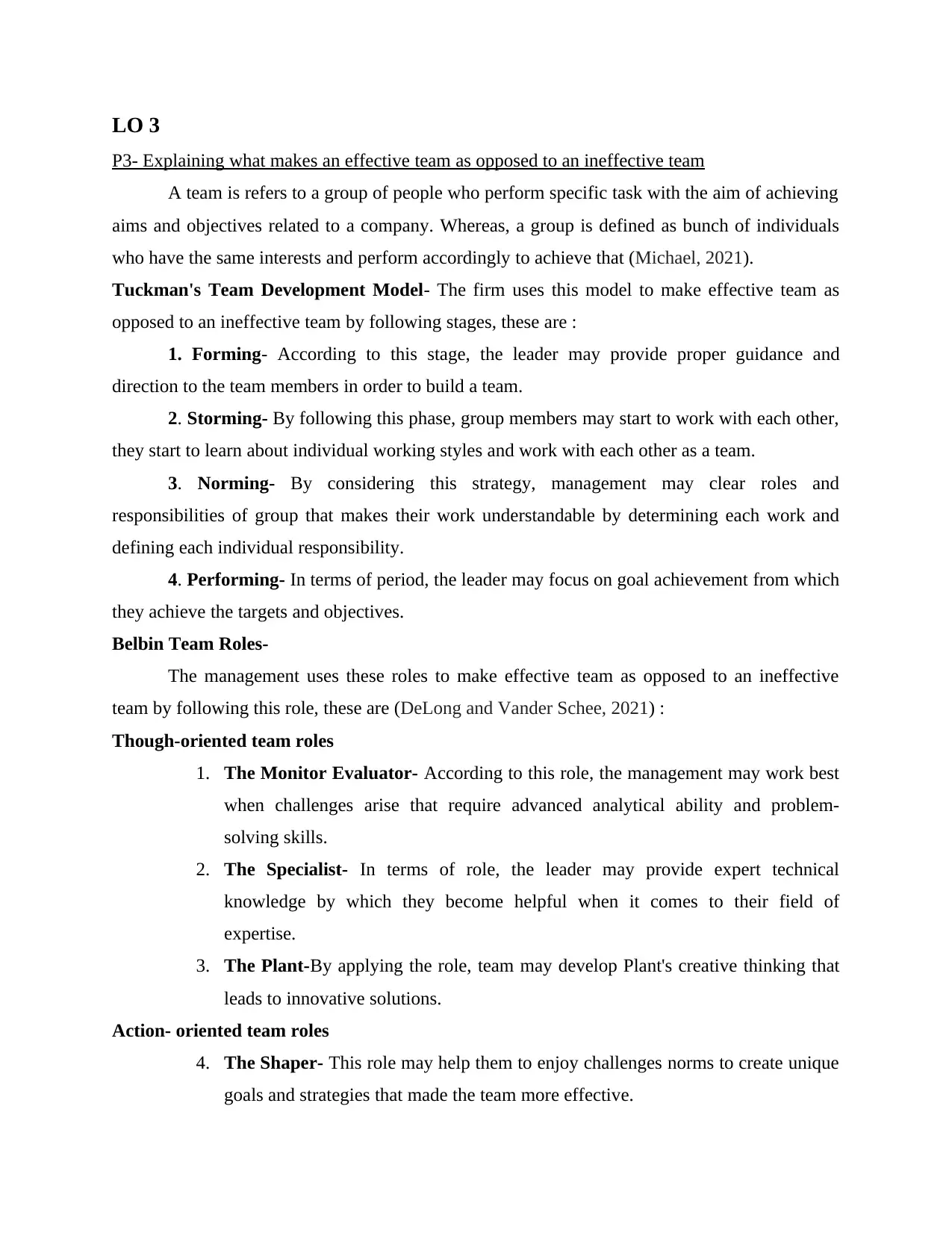
LO 3
P3- Explaining what makes an effective team as opposed to an ineffective team
A team is refers to a group of people who perform specific task with the aim of achieving
aims and objectives related to a company. Whereas, a group is defined as bunch of individuals
who have the same interests and perform accordingly to achieve that (Michael, 2021).
Tuckman's Team Development Model- The firm uses this model to make effective team as
opposed to an ineffective team by following stages, these are :
1. Forming- According to this stage, the leader may provide proper guidance and
direction to the team members in order to build a team.
2. Storming- By following this phase, group members may start to work with each other,
they start to learn about individual working styles and work with each other as a team.
3. Norming- By considering this strategy, management may clear roles and
responsibilities of group that makes their work understandable by determining each work and
defining each individual responsibility.
4. Performing- In terms of period, the leader may focus on goal achievement from which
they achieve the targets and objectives.
Belbin Team Roles-
The management uses these roles to make effective team as opposed to an ineffective
team by following this role, these are (DeLong and Vander Schee, 2021) :
Though-oriented team roles
1. The Monitor Evaluator- According to this role, the management may work best
when challenges arise that require advanced analytical ability and problem-
solving skills.
2. The Specialist- In terms of role, the leader may provide expert technical
knowledge by which they become helpful when it comes to their field of
expertise.
3. The Plant-By applying the role, team may develop Plant's creative thinking that
leads to innovative solutions.
Action- oriented team roles
4. The Shaper- This role may help them to enjoy challenges norms to create unique
goals and strategies that made the team more effective.
P3- Explaining what makes an effective team as opposed to an ineffective team
A team is refers to a group of people who perform specific task with the aim of achieving
aims and objectives related to a company. Whereas, a group is defined as bunch of individuals
who have the same interests and perform accordingly to achieve that (Michael, 2021).
Tuckman's Team Development Model- The firm uses this model to make effective team as
opposed to an ineffective team by following stages, these are :
1. Forming- According to this stage, the leader may provide proper guidance and
direction to the team members in order to build a team.
2. Storming- By following this phase, group members may start to work with each other,
they start to learn about individual working styles and work with each other as a team.
3. Norming- By considering this strategy, management may clear roles and
responsibilities of group that makes their work understandable by determining each work and
defining each individual responsibility.
4. Performing- In terms of period, the leader may focus on goal achievement from which
they achieve the targets and objectives.
Belbin Team Roles-
The management uses these roles to make effective team as opposed to an ineffective
team by following this role, these are (DeLong and Vander Schee, 2021) :
Though-oriented team roles
1. The Monitor Evaluator- According to this role, the management may work best
when challenges arise that require advanced analytical ability and problem-
solving skills.
2. The Specialist- In terms of role, the leader may provide expert technical
knowledge by which they become helpful when it comes to their field of
expertise.
3. The Plant-By applying the role, team may develop Plant's creative thinking that
leads to innovative solutions.
Action- oriented team roles
4. The Shaper- This role may help them to enjoy challenges norms to create unique
goals and strategies that made the team more effective.
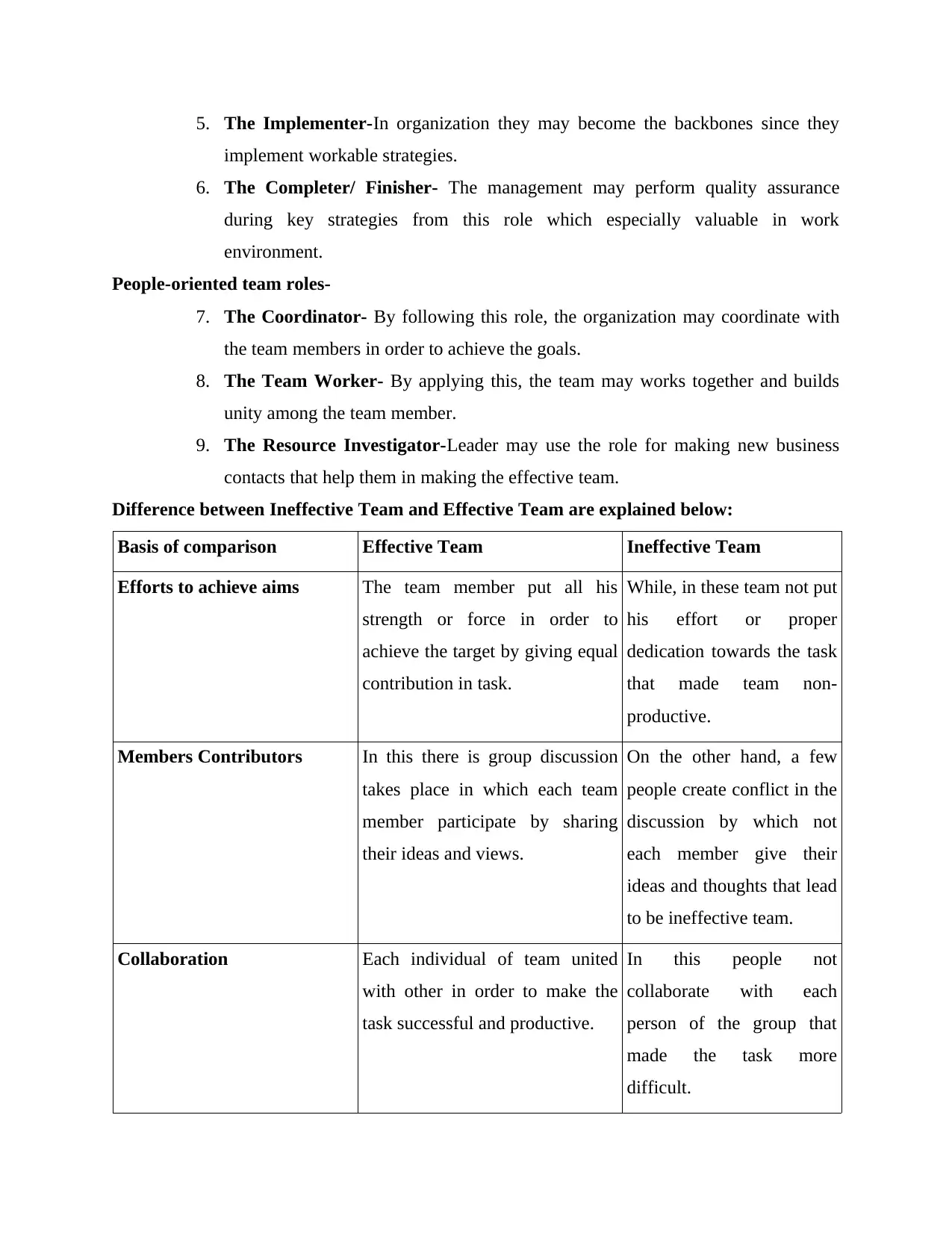
5. The Implementer-In organization they may become the backbones since they
implement workable strategies.
6. The Completer/ Finisher- The management may perform quality assurance
during key strategies from this role which especially valuable in work
environment.
People-oriented team roles-
7. The Coordinator- By following this role, the organization may coordinate with
the team members in order to achieve the goals.
8. The Team Worker- By applying this, the team may works together and builds
unity among the team member.
9. The Resource Investigator-Leader may use the role for making new business
contacts that help them in making the effective team.
Difference between Ineffective Team and Effective Team are explained below:
Basis of comparison Effective Team Ineffective Team
Efforts to achieve aims The team member put all his
strength or force in order to
achieve the target by giving equal
contribution in task.
While, in these team not put
his effort or proper
dedication towards the task
that made team non-
productive.
Members Contributors In this there is group discussion
takes place in which each team
member participate by sharing
their ideas and views.
On the other hand, a few
people create conflict in the
discussion by which not
each member give their
ideas and thoughts that lead
to be ineffective team.
Collaboration Each individual of team united
with other in order to make the
task successful and productive.
In this people not
collaborate with each
person of the group that
made the task more
difficult.
implement workable strategies.
6. The Completer/ Finisher- The management may perform quality assurance
during key strategies from this role which especially valuable in work
environment.
People-oriented team roles-
7. The Coordinator- By following this role, the organization may coordinate with
the team members in order to achieve the goals.
8. The Team Worker- By applying this, the team may works together and builds
unity among the team member.
9. The Resource Investigator-Leader may use the role for making new business
contacts that help them in making the effective team.
Difference between Ineffective Team and Effective Team are explained below:
Basis of comparison Effective Team Ineffective Team
Efforts to achieve aims The team member put all his
strength or force in order to
achieve the target by giving equal
contribution in task.
While, in these team not put
his effort or proper
dedication towards the task
that made team non-
productive.
Members Contributors In this there is group discussion
takes place in which each team
member participate by sharing
their ideas and views.
On the other hand, a few
people create conflict in the
discussion by which not
each member give their
ideas and thoughts that lead
to be ineffective team.
Collaboration Each individual of team united
with other in order to make the
task successful and productive.
In this people not
collaborate with each
person of the group that
made the task more
difficult.
Secure Best Marks with AI Grader
Need help grading? Try our AI Grader for instant feedback on your assignments.
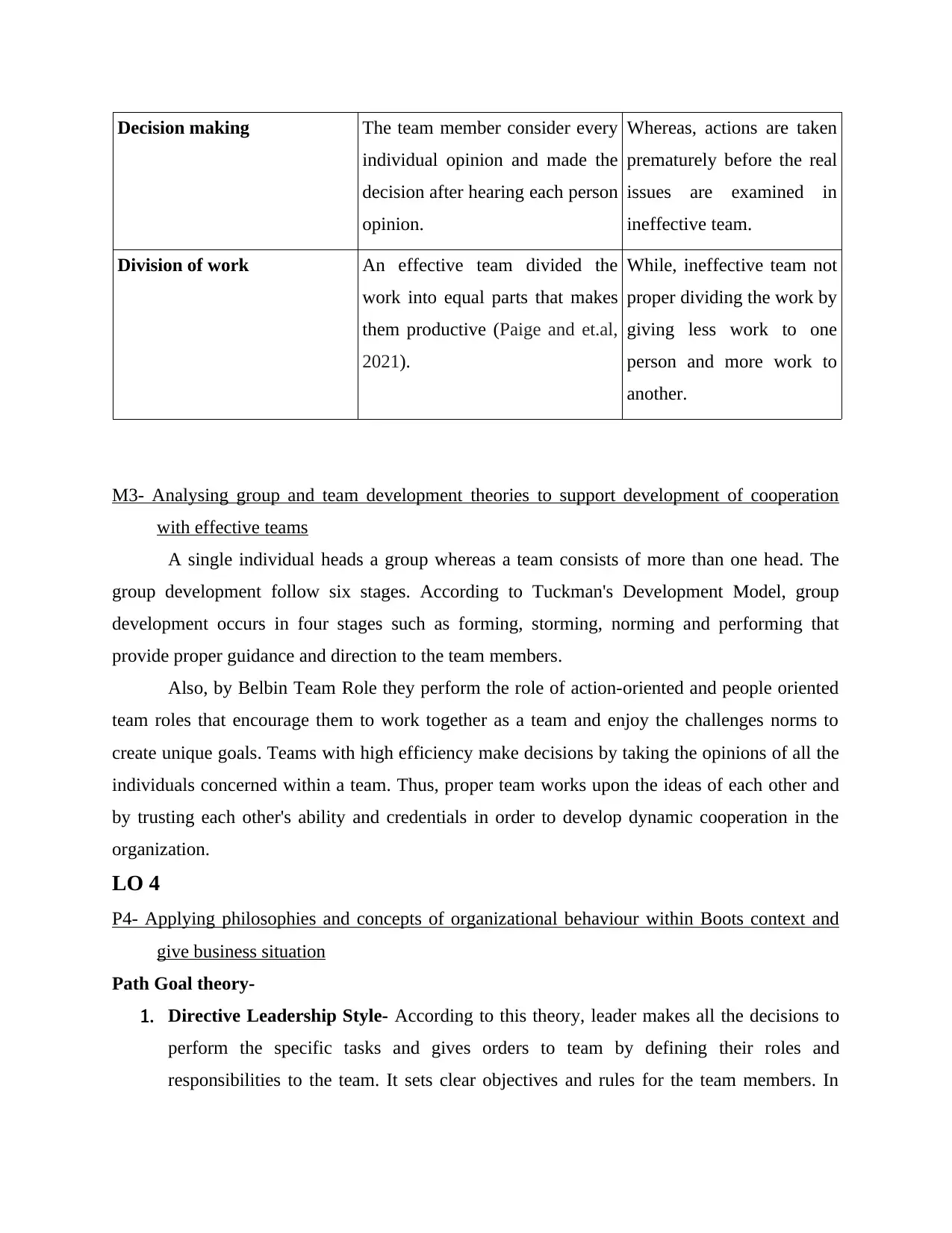
Decision making The team member consider every
individual opinion and made the
decision after hearing each person
opinion.
Whereas, actions are taken
prematurely before the real
issues are examined in
ineffective team.
Division of work An effective team divided the
work into equal parts that makes
them productive (Paige and et.al,
2021).
While, ineffective team not
proper dividing the work by
giving less work to one
person and more work to
another.
M3- Analysing group and team development theories to support development of cooperation
with effective teams
A single individual heads a group whereas a team consists of more than one head. The
group development follow six stages. According to Tuckman's Development Model, group
development occurs in four stages such as forming, storming, norming and performing that
provide proper guidance and direction to the team members.
Also, by Belbin Team Role they perform the role of action-oriented and people oriented
team roles that encourage them to work together as a team and enjoy the challenges norms to
create unique goals. Teams with high efficiency make decisions by taking the opinions of all the
individuals concerned within a team. Thus, proper team works upon the ideas of each other and
by trusting each other's ability and credentials in order to develop dynamic cooperation in the
organization.
LO 4
P4- Applying philosophies and concepts of organizational behaviour within Boots context and
give business situation
Path Goal theory-
1. Directive Leadership Style- According to this theory, leader makes all the decisions to
perform the specific tasks and gives orders to team by defining their roles and
responsibilities to the team. It sets clear objectives and rules for the team members. In
individual opinion and made the
decision after hearing each person
opinion.
Whereas, actions are taken
prematurely before the real
issues are examined in
ineffective team.
Division of work An effective team divided the
work into equal parts that makes
them productive (Paige and et.al,
2021).
While, ineffective team not
proper dividing the work by
giving less work to one
person and more work to
another.
M3- Analysing group and team development theories to support development of cooperation
with effective teams
A single individual heads a group whereas a team consists of more than one head. The
group development follow six stages. According to Tuckman's Development Model, group
development occurs in four stages such as forming, storming, norming and performing that
provide proper guidance and direction to the team members.
Also, by Belbin Team Role they perform the role of action-oriented and people oriented
team roles that encourage them to work together as a team and enjoy the challenges norms to
create unique goals. Teams with high efficiency make decisions by taking the opinions of all the
individuals concerned within a team. Thus, proper team works upon the ideas of each other and
by trusting each other's ability and credentials in order to develop dynamic cooperation in the
organization.
LO 4
P4- Applying philosophies and concepts of organizational behaviour within Boots context and
give business situation
Path Goal theory-
1. Directive Leadership Style- According to this theory, leader makes all the decisions to
perform the specific tasks and gives orders to team by defining their roles and
responsibilities to the team. It sets clear objectives and rules for the team members. In
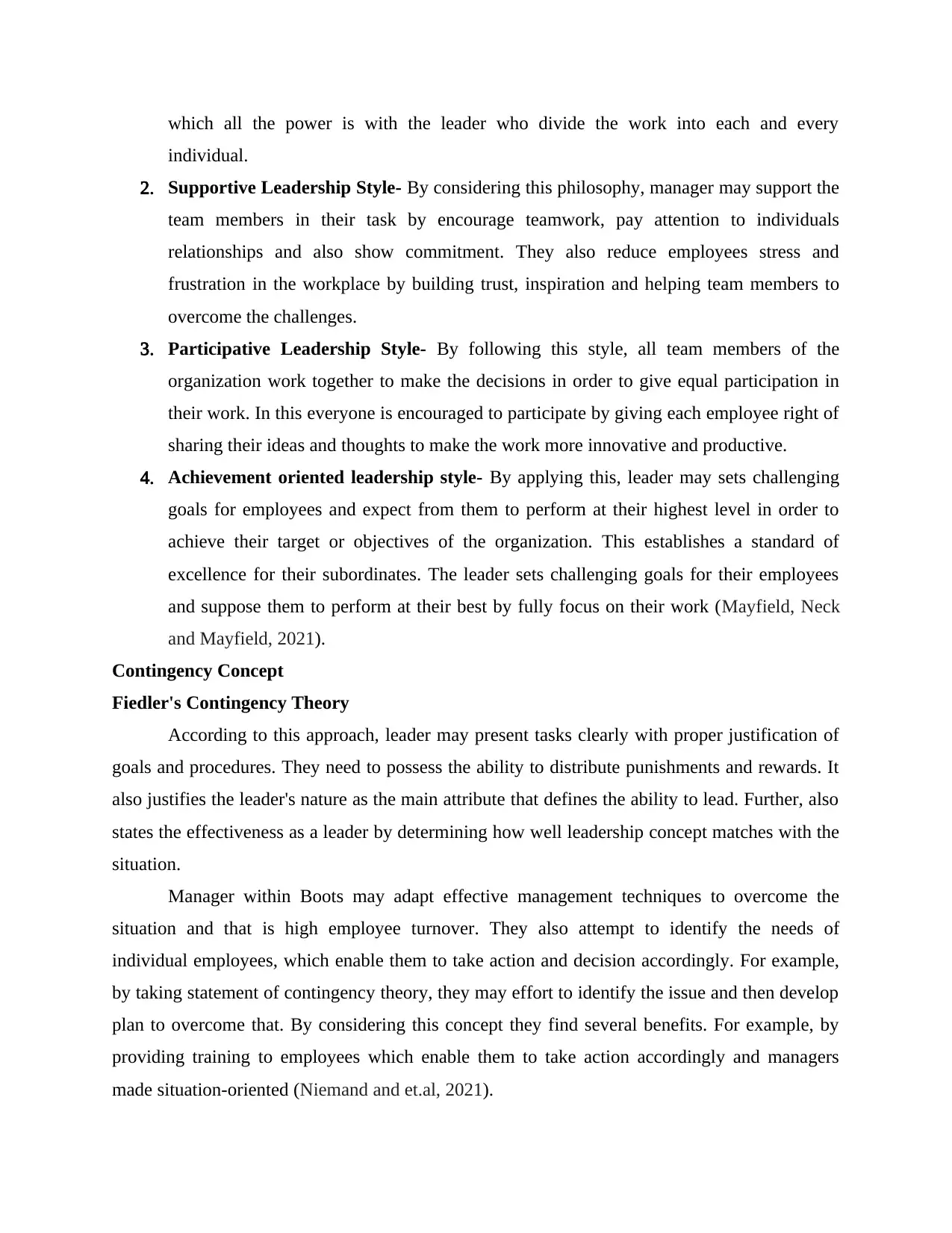
which all the power is with the leader who divide the work into each and every
individual.
2. Supportive Leadership Style- By considering this philosophy, manager may support the
team members in their task by encourage teamwork, pay attention to individuals
relationships and also show commitment. They also reduce employees stress and
frustration in the workplace by building trust, inspiration and helping team members to
overcome the challenges.
3. Participative Leadership Style- By following this style, all team members of the
organization work together to make the decisions in order to give equal participation in
their work. In this everyone is encouraged to participate by giving each employee right of
sharing their ideas and thoughts to make the work more innovative and productive.
4. Achievement oriented leadership style- By applying this, leader may sets challenging
goals for employees and expect from them to perform at their highest level in order to
achieve their target or objectives of the organization. This establishes a standard of
excellence for their subordinates. The leader sets challenging goals for their employees
and suppose them to perform at their best by fully focus on their work (Mayfield, Neck
and Mayfield, 2021).
Contingency Concept
Fiedler's Contingency Theory
According to this approach, leader may present tasks clearly with proper justification of
goals and procedures. They need to possess the ability to distribute punishments and rewards. It
also justifies the leader's nature as the main attribute that defines the ability to lead. Further, also
states the effectiveness as a leader by determining how well leadership concept matches with the
situation.
Manager within Boots may adapt effective management techniques to overcome the
situation and that is high employee turnover. They also attempt to identify the needs of
individual employees, which enable them to take action and decision accordingly. For example,
by taking statement of contingency theory, they may effort to identify the issue and then develop
plan to overcome that. By considering this concept they find several benefits. For example, by
providing training to employees which enable them to take action accordingly and managers
made situation-oriented (Niemand and et.al, 2021).
individual.
2. Supportive Leadership Style- By considering this philosophy, manager may support the
team members in their task by encourage teamwork, pay attention to individuals
relationships and also show commitment. They also reduce employees stress and
frustration in the workplace by building trust, inspiration and helping team members to
overcome the challenges.
3. Participative Leadership Style- By following this style, all team members of the
organization work together to make the decisions in order to give equal participation in
their work. In this everyone is encouraged to participate by giving each employee right of
sharing their ideas and thoughts to make the work more innovative and productive.
4. Achievement oriented leadership style- By applying this, leader may sets challenging
goals for employees and expect from them to perform at their highest level in order to
achieve their target or objectives of the organization. This establishes a standard of
excellence for their subordinates. The leader sets challenging goals for their employees
and suppose them to perform at their best by fully focus on their work (Mayfield, Neck
and Mayfield, 2021).
Contingency Concept
Fiedler's Contingency Theory
According to this approach, leader may present tasks clearly with proper justification of
goals and procedures. They need to possess the ability to distribute punishments and rewards. It
also justifies the leader's nature as the main attribute that defines the ability to lead. Further, also
states the effectiveness as a leader by determining how well leadership concept matches with the
situation.
Manager within Boots may adapt effective management techniques to overcome the
situation and that is high employee turnover. They also attempt to identify the needs of
individual employees, which enable them to take action and decision accordingly. For example,
by taking statement of contingency theory, they may effort to identify the issue and then develop
plan to overcome that. By considering this concept they find several benefits. For example, by
providing training to employees which enable them to take action accordingly and managers
made situation-oriented (Niemand and et.al, 2021).
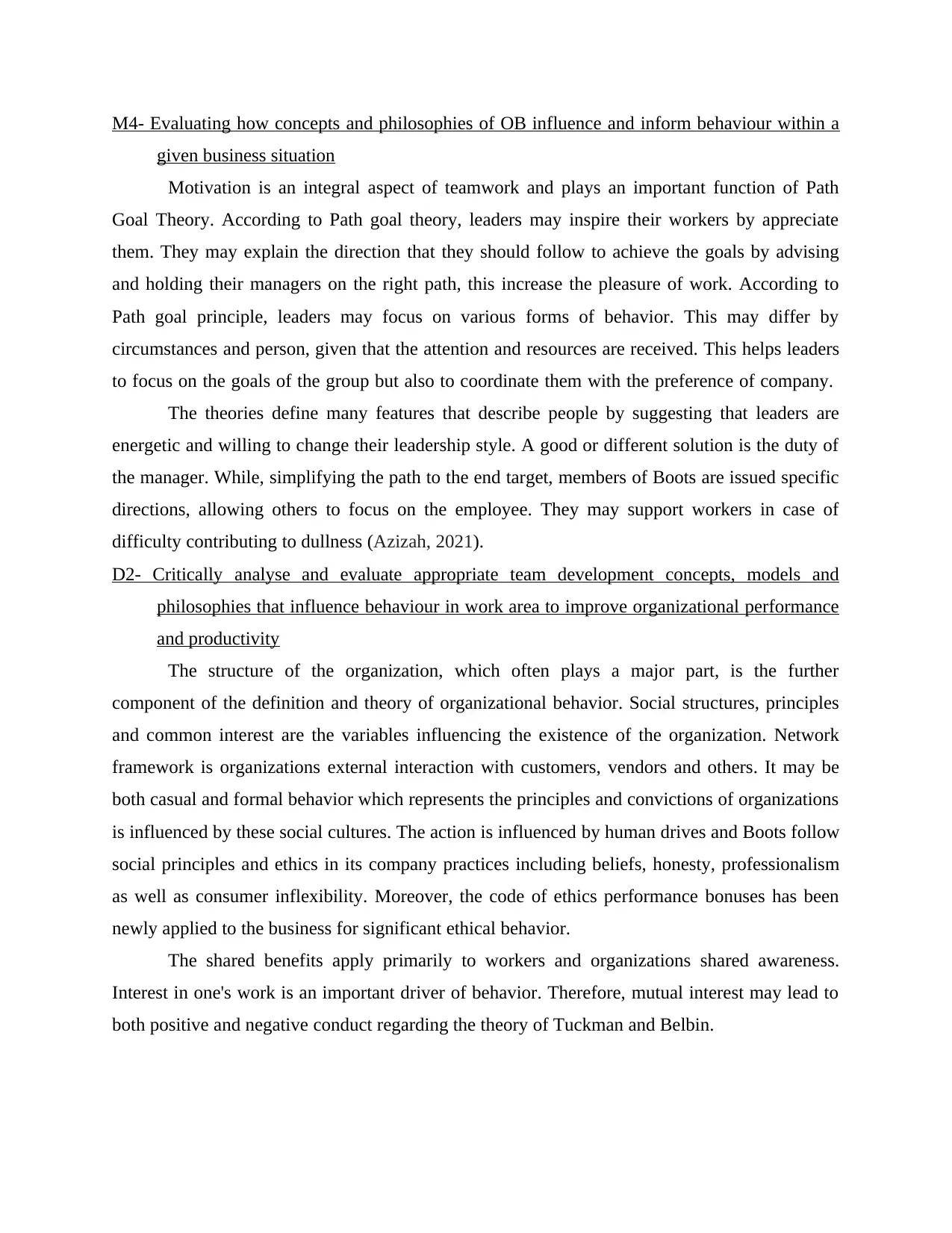
M4- Evaluating how concepts and philosophies of OB influence and inform behaviour within a
given business situation
Motivation is an integral aspect of teamwork and plays an important function of Path
Goal Theory. According to Path goal theory, leaders may inspire their workers by appreciate
them. They may explain the direction that they should follow to achieve the goals by advising
and holding their managers on the right path, this increase the pleasure of work. According to
Path goal principle, leaders may focus on various forms of behavior. This may differ by
circumstances and person, given that the attention and resources are received. This helps leaders
to focus on the goals of the group but also to coordinate them with the preference of company.
The theories define many features that describe people by suggesting that leaders are
energetic and willing to change their leadership style. A good or different solution is the duty of
the manager. While, simplifying the path to the end target, members of Boots are issued specific
directions, allowing others to focus on the employee. They may support workers in case of
difficulty contributing to dullness (Azizah, 2021).
D2- Critically analyse and evaluate appropriate team development concepts, models and
philosophies that influence behaviour in work area to improve organizational performance
and productivity
The structure of the organization, which often plays a major part, is the further
component of the definition and theory of organizational behavior. Social structures, principles
and common interest are the variables influencing the existence of the organization. Network
framework is organizations external interaction with customers, vendors and others. It may be
both casual and formal behavior which represents the principles and convictions of organizations
is influenced by these social cultures. The action is influenced by human drives and Boots follow
social principles and ethics in its company practices including beliefs, honesty, professionalism
as well as consumer inflexibility. Moreover, the code of ethics performance bonuses has been
newly applied to the business for significant ethical behavior.
The shared benefits apply primarily to workers and organizations shared awareness.
Interest in one's work is an important driver of behavior. Therefore, mutual interest may lead to
both positive and negative conduct regarding the theory of Tuckman and Belbin.
given business situation
Motivation is an integral aspect of teamwork and plays an important function of Path
Goal Theory. According to Path goal theory, leaders may inspire their workers by appreciate
them. They may explain the direction that they should follow to achieve the goals by advising
and holding their managers on the right path, this increase the pleasure of work. According to
Path goal principle, leaders may focus on various forms of behavior. This may differ by
circumstances and person, given that the attention and resources are received. This helps leaders
to focus on the goals of the group but also to coordinate them with the preference of company.
The theories define many features that describe people by suggesting that leaders are
energetic and willing to change their leadership style. A good or different solution is the duty of
the manager. While, simplifying the path to the end target, members of Boots are issued specific
directions, allowing others to focus on the employee. They may support workers in case of
difficulty contributing to dullness (Azizah, 2021).
D2- Critically analyse and evaluate appropriate team development concepts, models and
philosophies that influence behaviour in work area to improve organizational performance
and productivity
The structure of the organization, which often plays a major part, is the further
component of the definition and theory of organizational behavior. Social structures, principles
and common interest are the variables influencing the existence of the organization. Network
framework is organizations external interaction with customers, vendors and others. It may be
both casual and formal behavior which represents the principles and convictions of organizations
is influenced by these social cultures. The action is influenced by human drives and Boots follow
social principles and ethics in its company practices including beliefs, honesty, professionalism
as well as consumer inflexibility. Moreover, the code of ethics performance bonuses has been
newly applied to the business for significant ethical behavior.
The shared benefits apply primarily to workers and organizations shared awareness.
Interest in one's work is an important driver of behavior. Therefore, mutual interest may lead to
both positive and negative conduct regarding the theory of Tuckman and Belbin.
Paraphrase This Document
Need a fresh take? Get an instant paraphrase of this document with our AI Paraphraser
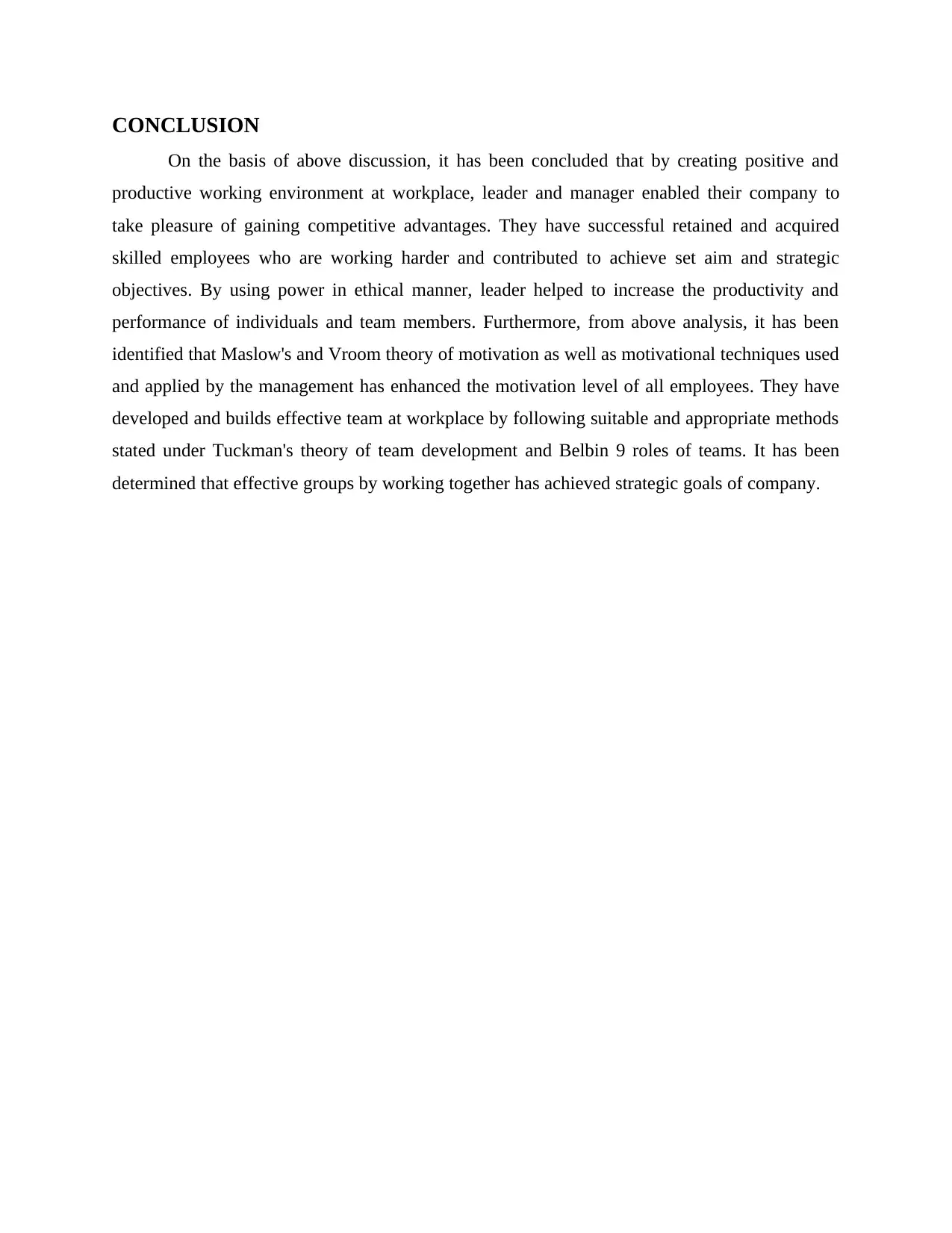
CONCLUSION
On the basis of above discussion, it has been concluded that by creating positive and
productive working environment at workplace, leader and manager enabled their company to
take pleasure of gaining competitive advantages. They have successful retained and acquired
skilled employees who are working harder and contributed to achieve set aim and strategic
objectives. By using power in ethical manner, leader helped to increase the productivity and
performance of individuals and team members. Furthermore, from above analysis, it has been
identified that Maslow's and Vroom theory of motivation as well as motivational techniques used
and applied by the management has enhanced the motivation level of all employees. They have
developed and builds effective team at workplace by following suitable and appropriate methods
stated under Tuckman's theory of team development and Belbin 9 roles of teams. It has been
determined that effective groups by working together has achieved strategic goals of company.
On the basis of above discussion, it has been concluded that by creating positive and
productive working environment at workplace, leader and manager enabled their company to
take pleasure of gaining competitive advantages. They have successful retained and acquired
skilled employees who are working harder and contributed to achieve set aim and strategic
objectives. By using power in ethical manner, leader helped to increase the productivity and
performance of individuals and team members. Furthermore, from above analysis, it has been
identified that Maslow's and Vroom theory of motivation as well as motivational techniques used
and applied by the management has enhanced the motivation level of all employees. They have
developed and builds effective team at workplace by following suitable and appropriate methods
stated under Tuckman's theory of team development and Belbin 9 roles of teams. It has been
determined that effective groups by working together has achieved strategic goals of company.
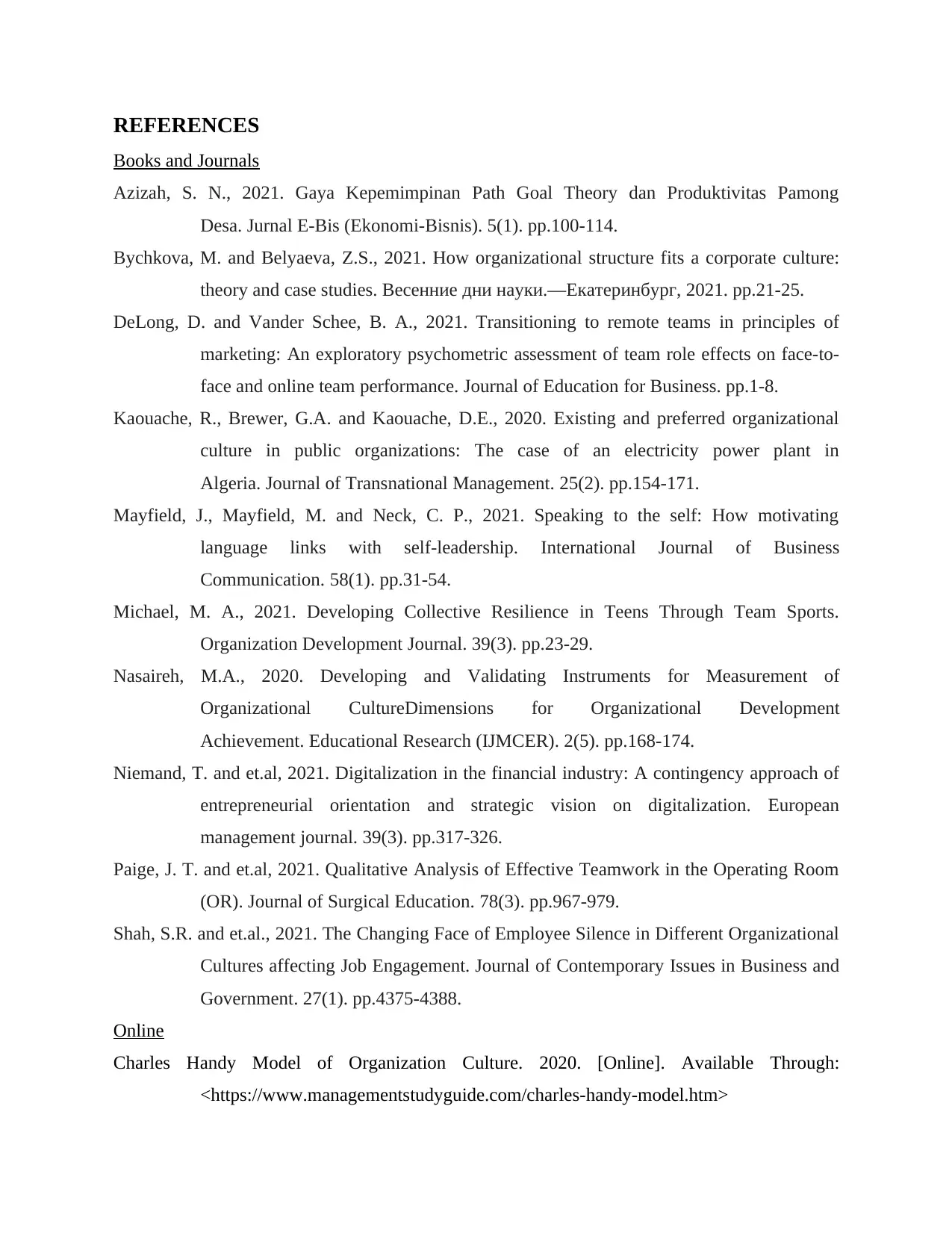
REFERENCES
Books and Journals
Azizah, S. N., 2021. Gaya Kepemimpinan Path Goal Theory dan Produktivitas Pamong
Desa. Jurnal E-Bis (Ekonomi-Bisnis). 5(1). pp.100-114.
Bychkova, M. and Belyaeva, Z.S., 2021. How organizational structure fits a corporate culture:
theory and case studies. Весенние дни науки.—Екатеринбург, 2021. pp.21-25.
DeLong, D. and Vander Schee, B. A., 2021. Transitioning to remote teams in principles of
marketing: An exploratory psychometric assessment of team role effects on face-to-
face and online team performance. Journal of Education for Business. pp.1-8.
Kaouache, R., Brewer, G.A. and Kaouache, D.E., 2020. Existing and preferred organizational
culture in public organizations: The case of an electricity power plant in
Algeria. Journal of Transnational Management. 25(2). pp.154-171.
Mayfield, J., Mayfield, M. and Neck, C. P., 2021. Speaking to the self: How motivating
language links with self-leadership. International Journal of Business
Communication. 58(1). pp.31-54.
Michael, M. A., 2021. Developing Collective Resilience in Teens Through Team Sports.
Organization Development Journal. 39(3). pp.23-29.
Nasaireh, M.A., 2020. Developing and Validating Instruments for Measurement of
Organizational CultureDimensions for Organizational Development
Achievement. Educational Research (IJMCER). 2(5). pp.168-174.
Niemand, T. and et.al, 2021. Digitalization in the financial industry: A contingency approach of
entrepreneurial orientation and strategic vision on digitalization. European
management journal. 39(3). pp.317-326.
Paige, J. T. and et.al, 2021. Qualitative Analysis of Effective Teamwork in the Operating Room
(OR). Journal of Surgical Education. 78(3). pp.967-979.
Shah, S.R. and et.al., 2021. The Changing Face of Employee Silence in Different Organizational
Cultures affecting Job Engagement. Journal of Contemporary Issues in Business and
Government. 27(1). pp.4375-4388.
Online
Charles Handy Model of Organization Culture. 2020. [Online]. Available Through:
<https://www.managementstudyguide.com/charles-handy-model.htm>
Books and Journals
Azizah, S. N., 2021. Gaya Kepemimpinan Path Goal Theory dan Produktivitas Pamong
Desa. Jurnal E-Bis (Ekonomi-Bisnis). 5(1). pp.100-114.
Bychkova, M. and Belyaeva, Z.S., 2021. How organizational structure fits a corporate culture:
theory and case studies. Весенние дни науки.—Екатеринбург, 2021. pp.21-25.
DeLong, D. and Vander Schee, B. A., 2021. Transitioning to remote teams in principles of
marketing: An exploratory psychometric assessment of team role effects on face-to-
face and online team performance. Journal of Education for Business. pp.1-8.
Kaouache, R., Brewer, G.A. and Kaouache, D.E., 2020. Existing and preferred organizational
culture in public organizations: The case of an electricity power plant in
Algeria. Journal of Transnational Management. 25(2). pp.154-171.
Mayfield, J., Mayfield, M. and Neck, C. P., 2021. Speaking to the self: How motivating
language links with self-leadership. International Journal of Business
Communication. 58(1). pp.31-54.
Michael, M. A., 2021. Developing Collective Resilience in Teens Through Team Sports.
Organization Development Journal. 39(3). pp.23-29.
Nasaireh, M.A., 2020. Developing and Validating Instruments for Measurement of
Organizational CultureDimensions for Organizational Development
Achievement. Educational Research (IJMCER). 2(5). pp.168-174.
Niemand, T. and et.al, 2021. Digitalization in the financial industry: A contingency approach of
entrepreneurial orientation and strategic vision on digitalization. European
management journal. 39(3). pp.317-326.
Paige, J. T. and et.al, 2021. Qualitative Analysis of Effective Teamwork in the Operating Room
(OR). Journal of Surgical Education. 78(3). pp.967-979.
Shah, S.R. and et.al., 2021. The Changing Face of Employee Silence in Different Organizational
Cultures affecting Job Engagement. Journal of Contemporary Issues in Business and
Government. 27(1). pp.4375-4388.
Online
Charles Handy Model of Organization Culture. 2020. [Online]. Available Through:
<https://www.managementstudyguide.com/charles-handy-model.htm>
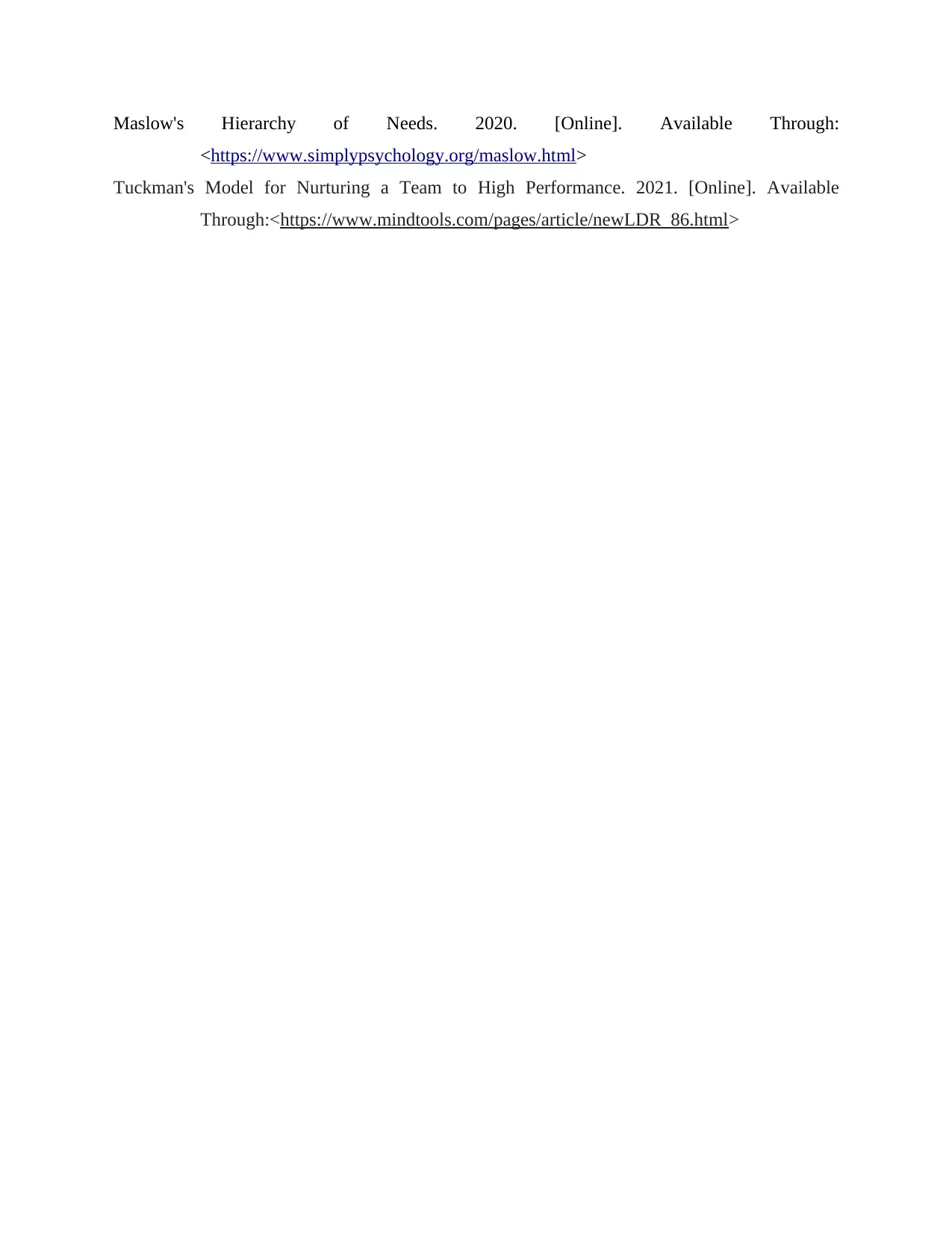
Maslow's Hierarchy of Needs. 2020. [Online]. Available Through:
<https://www.simplypsychology.org/maslow.html>
Tuckman's Model for Nurturing a Team to High Performance. 2021. [Online]. Available
Through:<https://www.mindtools.com/pages/article/newLDR_86.html>
<https://www.simplypsychology.org/maslow.html>
Tuckman's Model for Nurturing a Team to High Performance. 2021. [Online]. Available
Through:<https://www.mindtools.com/pages/article/newLDR_86.html>
1 out of 16
Related Documents
Your All-in-One AI-Powered Toolkit for Academic Success.
+13062052269
info@desklib.com
Available 24*7 on WhatsApp / Email
![[object Object]](/_next/static/media/star-bottom.7253800d.svg)
Unlock your academic potential
© 2024 | Zucol Services PVT LTD | All rights reserved.





